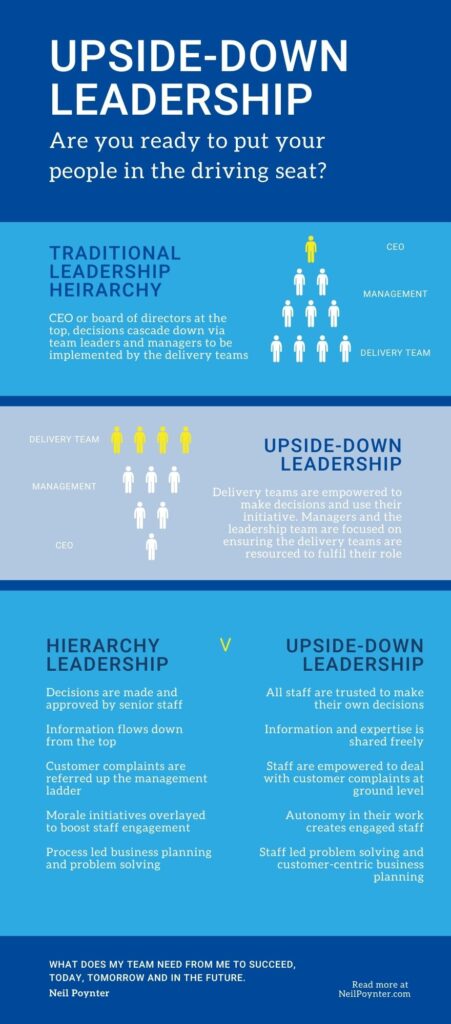What is upside down leadership?
Tuesday April 6, 2021
What would happen in your organisation if you turned your leadership hierarchy on its head so the most important people, at the top of the hierarchy, were the delivery teams?
What is upside-down leadership?
Upside-down leadership, also known as servant leadership, is a model that has been around for several decades and can have huge benefits to an organisation. At its core is the belief that the CEO, leadership team or founder has a role to serve their staff rather than their shareholders.
Upside down leadership doesn’t do away with responsibilities attached to roles, leaders still need to decide on strategic direction, HR still needs to support staff recruitment and welfare, but it removes the focus of leadership on managing the doing in the organisation and empowers staff to find the best way to deliver their work.
Examples of upside-down leadership in business
In the UK one of the best-known examples of upside-down leadership is the Timpsons group. The customer-facing staff are given the trust and responsibility to run their shops in the best way they see fit. John Timpson describes it thus;
“We trust branch colleagues to do whatever they believe will give an amazing service: They can change prices, they can invent new displays and they can pay up to £500 to settle a complaint.”
John Timpson
This approach isn’t confined to the customer-facing staff, every member of the team has the authority to do their job the best way that they see fit. Timpsons have been using this approach for over 20 years and it has allowed them to grow the number of shoe repair sites as well as expand into new services.
In the US, Nordstrom is another retail business that empowers its customer-facing staff to provide outstanding customer service. Retail staff are encouraged to “use good judgement in all situations”. This strategy is so effective that Nordstrom customer service has become almost legendary and impacts the bottom line by encouraging customer loyalty and word of mouth recommendations.
Trusting people and giving them autonomy in their work creates a culture of proactive problem-solving. Giving people the freedom to solve problems without having to refer up a chain of command or follow a set of procedures, means that a customer complaint is resolved quickly and easily rather than becoming a time consuming and costly problem.
While it may seem easy and obvious to trust people to prioritise customer care, both Nordstrum and Timpson’s approach also encourages creativity and innovation. The growth of The Watch Workshop, a whole new retail offer, came about at Timpsons when a shop manager highlighted how many watch repair sales their shoe repair shop was doing.
Staff that are empowered to take decisions also feel empowered to share their experience and insight, leading to a greater pool of ideas for a company to use to grow.
Trust as a part of upside-down leadership
The core concept of upside down leadership is trust.
Trust is neither micromanaging nor leaving people to get on with things without guidance or support. Instead of asking “what are you doing?” or “why are you doing that?” it is asking “what support do you need from me?” and “have you got everything you need for this project?”
Trust is a two-way street, which means that not only will your people know that you trust them, they will learn that they can trust you too. When you show you trust your teams they will feel confident in you as a leader and know that they can come to you when things go awry or they need more support, instead of struggling through because they’re fearful of asking for help.
The benefits of the trust and autonomy seen in upside-down leadership aren’t multiple. In their 2019 report, PwC found that employees who feel they can act with autonomy in their day-to-day work environment tend to have stronger job performance, higher job satisfaction and greater commitment to the organisation. Trust creates loyalty, pride in a person’s work and in the organisation, and creates an environment where future leaders are easy to identify and develop.
What does this mean for me and my business?
Turning your organisation’s approach to leadership upside-down is not something you can do overnight, John Timpson explains that even as the head of the organisation it took several years for his staff and business to get behind the concept.
However, the approach can be applied at a micro level to how you work with your team by changing the questions you ask, the way you listen and how you manage people and projects.
The idea of stepping away from old fashioned styles of directive leadership to empowering a team by serving them may feel counterintuitive, especially if you are used to sharing your experience to help others learn. Upside down leadership challenges people to walk away from the ego of leadership and centre their focus on their people not themselves.
It is asking the question;
“What does my team need from me to succeed, today, tomorrow and in the future?”
Neil Poynter
And then listening and taking action on the answers that come back.
I’ve created an infographic that explains more about upside-down leadership for you to share with your network.


